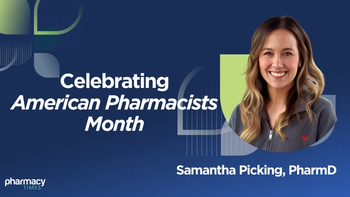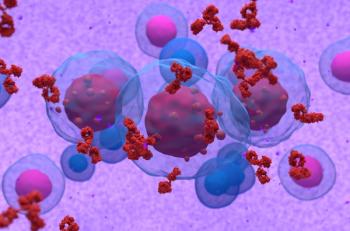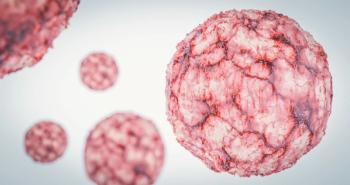
Novel IVIG Formulation KIG10 Is Effective, Well Tolerated in Adults With Primary Immunodeficiency
Key Takeaways
- KIG10 showed efficacy and tolerability in a phase 3 trial for primary immunodeficiency, with no serious drug-related adverse events reported.
- The trial's primary endpoint was the incidence of acute serious bacterial infections, aligning with FDA recommendations for IVIG products.
No acute serious bacterial infections were observed in a trial of patients with the debilitating immune disorder, a strong mark of safety and tolerability.
KIG10, a new 10% intravenous immunoglobulin (IVIG) product, was found to be effective and well tolerated in adult patients with primary immunodeficiency (PI), a positive first step in the potential development of the novel IVIG product.1
The data, presented as an abstract at the American College of Allergy, Asthma, & Immunology’s Annual Scientific Meeting in Boston, Massachusetts, was garnered from an open-label, prospective, single-arm, historically controlled, multicenter phase 3 trial.1,2
Enrolled patients with PI were treated with 200 mg/kg to 800 mg/kg of KIG10 every 21 or 28 days for 48 weeks, according to the trial protocol. In total, 59 individuals were enrolled in the trial, but 47 patients were ultimately deemed eligible to receive study treatment and be analyzed for safety and efficacy.1
The primary end point of the trial was incidence of acute serious bacterial infections (SBIs). In clinical trials of subjects with PI, the FDA recommends that the rate of SBIs be measured as a primary end point, with a statistical analysis demonstrating that the frequency of acute SBIs be less than 1 per subject per year.3
Patients’ baseline immunoglobin G (IgG) trough levels were evaluated by the investigators. Except for 1 patient, all post-baseline IgG trough levels reported were observed to be above the target level of ≥ 6 g/L at visit 7. The patient whose IgG levels were not above the target level was on a 28-day dosing schedule and presented with a history of chronic bronchitis. Additionally, an exacerbation had occurred in the months preceding visit 7.1
A total of 643 infusions of KIG10 were performed. Infusional adverse events (AEs) were reported for 80 infusions (12.4%), while 75 drug-related treatment-emergent AEs (TEAEs) occurred in 22 patients (46.8%), according to the investigators. The most commonly-reported event was headache, with 27 events being reported in 12 subjects (25.5%).1
In an important observation, no drug-related serious TEAEs, significant or life threatening TEAEs, AEs leading to study discontinuation, or hemolysis events were reported after KIG10 infusion. The study authors wrote that these pharmacokinetic parameters were comparable to other IVIG products licensed in the United States, a critical component to future opportunities for regulatory approval.1
Privigen, a 10% IVIG formulation, has been examined in patients with PI. In a 1-year study, the IVIG formulation had a rate of 0.08 acute SBIs per year, within the FDA’s recommended target. In a 2 ½ year extension of the trial, the rate of acute SBIs was 0.02, another strong result. Furthermore, a vast majority of the side effects reported in both the 1-year and 2 ½-year trials were deemed not serious, providing a standard for KIG10 to reach in future trials.3,4
PI weakens an individual’s immune system, which allows infections or other health complications to occur more frequently and easily. Oftentimes, those with PI were born missing immune defenses in their body or with their immune system working improperly, which leaves them susceptible to infections.5
Pharmacists and other treatment providers should observe for frequent or recurrent severe infections in individuals and note their responsiveness to treatment, as these could be signs of PI. From there, pharmacists can play a role in recommending treatment with IVIG or providing resources for patients to learn more about the infusion process and its benefits.5
REFERENCES
1. Calcinai M, Norton M, Gonzalez E, et al. Phase III, efficacy, safety, pharmacokinetics study of a new IVIG 10% (KIG10) in primary immunodeficiency. Annals of Allergy, Asthma & Immunology. 2024;133(6):S61. doi:10.1016/j.anai.2024.08.203
2. American College of Allergy, Asthma & Immunology. 2024 Annual Scientific Meeting. Podium to Practice: Advancing Allergy/Immunology Discovery. October 24-28, Boston, MA. Home Page. Accessed Online November 19, 2024. https://annualmeeting.acaai.org/2024/index.cfm
3. Hooper, JA. Intravenous immunoglobulins: Evolution of commercial IVIG preparations. Immunol Allergy Clin North Am. 2008;28(4):765-778. doi:10.1016/j.jac.2008.06.002
4. Privigen, Immune Gloublin Intravenous (Human); 10% Liquid. Safe & Effective. USA-PVG-0002-MAY21. Accessed Online November 19, 2024. https://www.privigen.com/safe-and-effective/pi
5. Mayo Clinic. Primary immunodeficiency. Mayo Clinic Staff. Last Updated March 12, 2022. Accessed Online November 19, 2024. https://www.mayoclinic.org/diseases-conditions/primary-immunodeficiency/symptoms-causes/syc-20376905#when-to-see-a-doctor
Newsletter
Stay informed on drug updates, treatment guidelines, and pharmacy practice trends—subscribe to Pharmacy Times for weekly clinical insights.

















































































































































































































